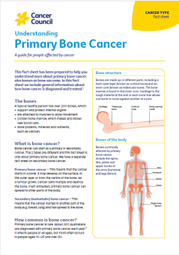- Home
- Primary bone cancer
- Diagnosis
Primary bone cancer diagnosis
If you have symptoms, your doctor will ask about your medical history and do a physical examination.
Learn more about:
Tests
It is likely that you will have some of the following tests:
| x-rays | Can show bone damage or whether new bone is growing |
| blood tests | Help check your overall health |
| CT and/or MRI scans | create pictures to highlight any bone abnormality |
| specialised scans | A small amount of radioactive solution is injected before a scan to highlight any cancerous areas in the body, e.g. PET, thallium or technetium scans |
| bone biopsy | collects some cells and tissues from the outer part of the affected bone. This is best done in a specialised sarcoma treatment centre. The biopsy may be done in one of two ways. In a core biopsy, a local anaesthetic is used to numb the area, then a sample is taken using a needle. A CT or ultrasound scan is used to guide the needle into place. In an open biopsy, under general anaesthesia the surgeon makes a cut in the skin to remove a piece of bone. The sample is also checked for genetic changes |
| bone marrow biopsy | a thin needle is used to remove a sample of marrow from the hip bone |
Selecting the bone site to biopsy
A bone biopsy is a specialised test. It is best to have the biopsy at the specialist treatment centre (see below) where you would be treated if it is cancer. The specialists will usually work together to decide the best site to place the needle. The site to biopsy must be carefully chosen so it doesn’t cause problems if further surgery is needed. This also helps ensure the sample is useful and reduces the risk of the cancer spreading.
Staging
The test results will help show where the cancer is and if it has spread. This is called staging. Knowing the stage helps your doctors plan your treatment.
Grades of primary bone cancer
Grading describes how quickly a cancer might grow. In general, the lower the grade, the better the prognosis.
| low grade | The cancer cells look like normal cells. They usually grow slowly and are less likely to spread. |
| high grade | The cancer cells look very abnormal. They grow quickly and are more likely to spread. |
Stages of primary bone cancer
Many cancers are staged using a system that divides them into 4 stages. But bone cancer is different. It is usually divided into localised or advanced. Ask your doctor to explain the stage of cancer to you.
| localised | The cancer contains low-grade cells; found in the bone in which it started. It can be removed by surgery (resectable) or not removed completely (non-resectable). |
| advanced (metastatic) | The cancer is any grade and has spread to other parts of the body (e.g. the lungs). |
Podcast: Tests and Cancer
Listen to more episodes of our podcast for people affected by cancer
More resources
Prof Peter Choong AO, Orthopaedic Surgeon, and Sir Hugh Devine Professor, St Vincent’s Hospital, and Head of Department of Surgery, The University of Melbourne, VIC; Catherine Chapman, Adolescent and Young Adult and Sarcoma Cancer Specialist Nurse, Division of Cancer and Ambulatory Support, Canberra Hospital, ACT; A/Prof Paul Craft AM, Medical Oncologist, Canberra Hospital and Australian National University, ACT; Belinda Fowlie, Bone Tumour Nurse Practitioner Candidate, SA Bone and Soft Tissue Tumour Unit, Flinders Medical Centre, SA; Prof Angela Hong, Radiation Oncologist, Chris O’Brien Lifehouse, and Clinical Professor, The University of Sydney, NSW; Vicki Moss, Nurse Practitioner, SA Bone and Soft Tissue Tumour Unit, Flinders Medical Centre, SA; A/Prof and Dr Marianne Phillips, Paediatric and Adolescent Oncologist and Palliative Care Physician, Perth Children’s Hospital, WA; Chris Sibthorpe, 13 11 20 Consultant, Cancer Council Queensland; Stephanie Webster, Consumer.
View the Cancer Council NSW editorial policy.
View all publications or call 13 11 20 for free printed copies.

